|
|
Couldn’t make last Friday’s Farm Tour?
The full story on Farm Tour 2016 |
|
May 26, 2016 |
by Mary Fioravanti
Editor's Note: Boundary County's Farm Tour
has become an informative and fun annual event,
the result of many hours of dedication,
coordination, and hard work by the Boundary
County Soil Conservation District and the Idaho
Farm Bureau, who work together every year to put
together and sponsor the Farm Tour. Our writer Mary Fioravanti
traveled on the Farm Tour
last Friday. Following is her report on her
experiences and impressions on the tour.
The annual Farm Tour organized by the Idaho Farm
Bureau was fascinating! Friday, May 20 a large
group of about 60 people traveled to various
places around Boundary County, and got a
personal look at our local habitats and farms.
The Farm Tour always presents a unique
opportunity for local production insights, and
is never quite the same because it changes
destinations from year to year. Featured on this
year's tour were visits to the Kootenai Tribe's
Sturgeon release into the Kootenai River, the
dikes along the river at Copeland, then we made
our way up to the Houck Farm in the Porthill
area where we observed
multiple projects.
Starting off with sturgeon
In the morning, we met at the fairgrounds and
our Farm Tour day began with a presentation from
the Kootenai Tribe of Idaho's Fish and Wildlife
Department about their restoration plan for the
Kootenai River. They have been putting an
aquaculture system into place and constantly
trying to improve the fish and wildlife habitat
of the river. The Tribe's Twin Rivers Sturgeon
and Burbot Hatchery, located at the confluence
of the Moyie and the Kootenai Rivers, is meant
to help restore viable fish populations in the
river. The hatchery tracks over 1,000 fish
breeds native to the river. They are quite
worried that the White Sturgeon population may
soon go extinct if they can't raise the numbers
again fairly quickly. Burbot fish are also
becoming increasingly threatened.
When our Farm Tour Bus traveled down to the
Search and Rescue dock at the Boundary County
Waterways Building, there were thousands of
juvenile White Sturgeon in tank trucks waiting
to be released into the Kootenai River. As part
of the magical experience, every person was
permitted and encouraged to personally release a
baby Sturgeon themselves. This was a rare and
exciting chance for Boundary County residents to
participate in such an influential way in this
significant operation.
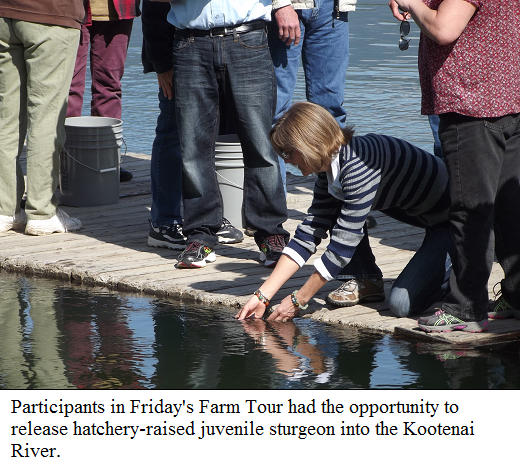
Don't laugh too hard, but I was frightened at
first that the Sturgeon might cut me with their
fins, but they were smooth and compliant. When I
released one into the water, it just gently
glided away into the depths. Many people may
disagree, but I found the baby Sturgeon to be so
cute! (It's funny how all babies are naturally
cute t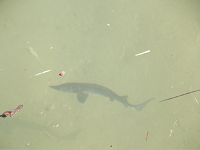 o
some degree). Along with many others on Friday's
Farm Tour, this was my favorite part of the day. o
some degree). Along with many others on Friday's
Farm Tour, this was my favorite part of the day.
Slowly but steadily, the Kootenai Tribe has been
adding nutrients to the river that are essential
for the fish. As you may know, the Tribe managed
several construction projects on the river last
summer and fall to increase the depths and
supply rocks so the fish can have spawning
nests.
Additionally, many people have asked why the
islands constructed as part of those projects
now look so cluttered. We learned that, in order
to protect trees and plants on the river islands
from beaver and geese damage, the workers
strategically placed shrubs and brush around the
newly-planted vegetation on the island. It is
those protective shrubs and brush that give the
islands their cluttered look. Eventually the new
vegetation will appear.
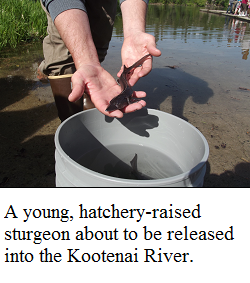
Part of the restoration plan includes capturing
male and female Sturgeon to collect eggs and
semen. They complete the fertilization process
and regulate the growth of the Sturgeon until
they are of age to be released into the river.
When it is time for them to be released, all of
them are tagged or marked with identification
which alerts the Tribe that they were once in
the hatchery, if the same fish are caught in the
future. We were informed that Sturgeon released
in the spring have a much higher survival rate
than those released in the fall.
White Sturgeon in particular live from 50-100
years, and physically cannot mate until they are
30 years old. They told us that if the current
Sturgeon survival rate holds up, there may be
less than 50 by the year 2030. Each year the
Tribe releases thousands of juvenile Sturgeon
into the river at springtime, but there is a
survival rate of only about 7-10%.
Dikes and flooding on the Kootenai River
After the Sturgeon release, we piled back on the
tour bus and drove up to
Copeland for a short time and got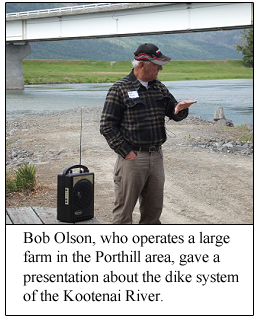 off at the
river bank there. While there, we listened to a
presentation given by Bob Olson, a third
generation farmer who operates a 3,000 acre farm
in the Porthill area. Mr. Olson has lived through and witnessed years of
Kootenai River flooding. His presentation
was about the dike inserts
around the river banks. Mr. Olson said there had to be miles of
dikes for both sides of the river banks, partly
because the river twists so much. The dikes were
built onto the banks to help protect the farms
on surrounding lands from high water charges. It
was interesting to hear his observation that the
land around the river is highest at the river
edge. He said that the biggest flood was in
1892, and the most recent and likely last floods
from the Kootenai River were in the late 1960's.
When Libby Dam was built, it again helped to
control flooding of the river. Formerly when
flooding was prominent, kids used to go on dike
patrol for flood watch, Mr. Olson told us. off at the
river bank there. While there, we listened to a
presentation given by Bob Olson, a third
generation farmer who operates a 3,000 acre farm
in the Porthill area. Mr. Olson has lived through and witnessed years of
Kootenai River flooding. His presentation
was about the dike inserts
around the river banks. Mr. Olson said there had to be miles of
dikes for both sides of the river banks, partly
because the river twists so much. The dikes were
built onto the banks to help protect the farms
on surrounding lands from high water charges. It
was interesting to hear his observation that the
land around the river is highest at the river
edge. He said that the biggest flood was in
1892, and the most recent and likely last floods
from the Kootenai River were in the late 1960's.
When Libby Dam was built, it again helped to
control flooding of the river. Formerly when
flooding was prominent, kids used to go on dike
patrol for flood watch, Mr. Olson told us.
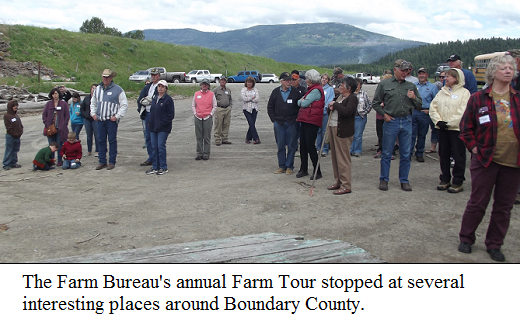
Learning about the role of forest
management in fire prevention
Next, we traveled up to the Houck Farm. We first
watched an astonishing forestry demonstration up
close to show us the impact of keeping our
forests managed effectively. The demonstration,
presented by Lee Colson of the U.S. Forest
Service, was a diorama of two miniature forests.
Keeping everything safe and contained, Mr.
Colson lit the two forest comparisons on fire
and we watched them go up in flames. The
wild-looking example caught everything on fire
in less than 20 seconds, and the cleaner one
took a couple of minutes. Mr. Colson made his
point clear about the importance of forest
management, and after elaborating more on the
subject, he gave us a Q & A session.
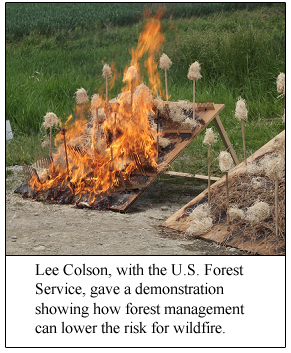
The presentation on the causes of Boundary
County's forest fires
of last summer was simply intriguing. One
cause mentioned was all of the peat found
underground in the Copeland valley and around
the mountains. It was hypothesized that all of
the peat had come from the debris of the last
ice age when the glaciers carved through our
area.
Interestingly, we were all informed that peat
has attributes similar to those of charcoal. The
peat is actually a compressed layer of organic
matter under the ground, extending anywhere from
the surface to 10 feet below. It acts as an
unrelinquishing chamber to hold fire.
When the peat gets hot it burns underground,
even if the surface with existing vegetation is
cool. The peat can burn for miles underground,
which is scary because the peat is always hot
and ready to ignite the surface. Sparks would
then seem to come from nowhere when a fire
starts, but the cause is the peat. Only farmers
in the area knew of the peat, but were unaware
of its damaging effects.
While we waited for our lunch to arrive, we were
also able to get a good look at the noxious
weeds invasive to North Idaho. There was a
display board showing noxious weeds in our area,
and why we shouldn't let them get out of hand.
When lunch had arrived, it was delicious and a
pleasant break for everyone! Lunch included
smoked steak slice sandwiches, cole slaw, beans,
desert and more! (All catered by Big
Daddy's Grill in Porthill). It was truly a high-end meal.
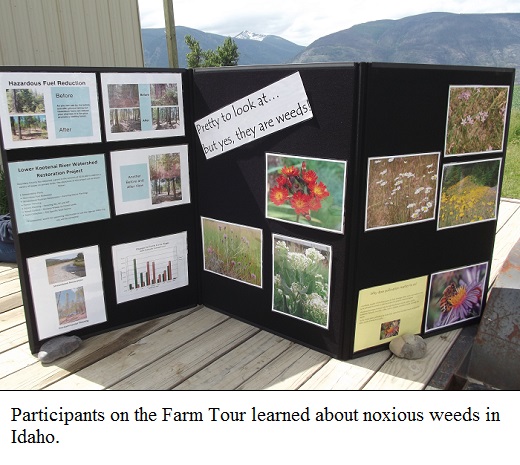
Visiting the Houck Farm
At the Houck Farm, there were so many things to
see. After lunch was finished and the rain had
passed, we listened to Tim Dillin talk about the
Houck Farm, started by his grandfather, and all
of the renovations it has gone through. In
addition to being a long-time farmer in Boundary
County, Mr. Dillin serves on the Board of the
Soil Conservation District, one of the groups
who annually organizes the Farm Tour. The Houck
Farm is about 1,600 acres. The crops grown on
the farm include wheat, barley, canola, garbanzo
beans, and new experiments with quinoa.
The farm has a lot of local support in our area.
Woods Meat of the Bonner County area is one
client, feeding barley from the Houck Farm to
their cattle. The farm's flour also reaches the
shelves of Super 1 Grocery and the Harvest Foods
Market in Bonners Ferry, Boundary County's Bread
Basket Bakery, and health food stores in both
the Sandpoint and Bonners Ferry areas, along
with other area merchants. The newly constructed
flour mill on the farm started out just as a
hobby, but as you can see in the photograph,
their mill developed so much business that sales
took off!
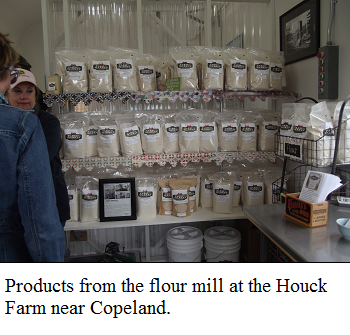
Lastly, the farming equipment is super
impressive! Mark Awbrey, an employee of Houck
Farm, along with Jeff Hood, explained that the
tractors are all linked to about 13 different
satellites that map out where the tractor needs
to go. This maps out the routes for the tractors
so that the crops are harvested perfectly, and
they aren't being damaged by being driven over
twice. In fact, the tractors have a built-in
mode to drive themselves when you punch your
desired route into the system. We got to test
this when they let us ride in the
auto-driven tractor to see for ourselves that it
does indeed work! One large tractor we saw had
multiple attachments with two commodity tanks
and a 36 foot long harvester. They said just
this alone equaled about $150,000. Wow! You
could buy a house for that price.
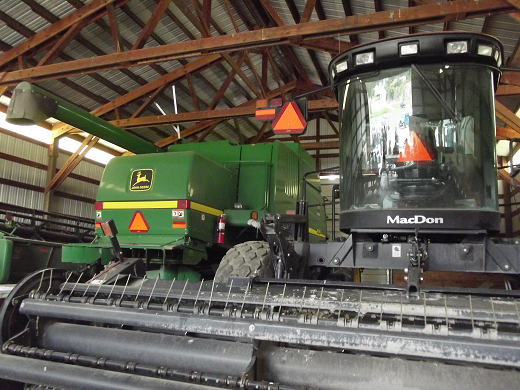
When the tour came to an end, I was well
satisfied. The day was very eventful,
educational, and fun! I never thought I would
ever be riding in an auto-drive tractor or
releasing a juvenile White Sturgeon into the
Kootenai River with my bare hands! Everything
was a really great experience and entertaining
as well. I highly recommend to others going on
the Farm Tour in the future if you have the
chance. You'll learn a thing or two, and enjoy
what Boundary County has to offer. That's all
for now! |
|
|
|
Questions or comments about this
article?
Click here to e-mail! |
|
|
|
|

